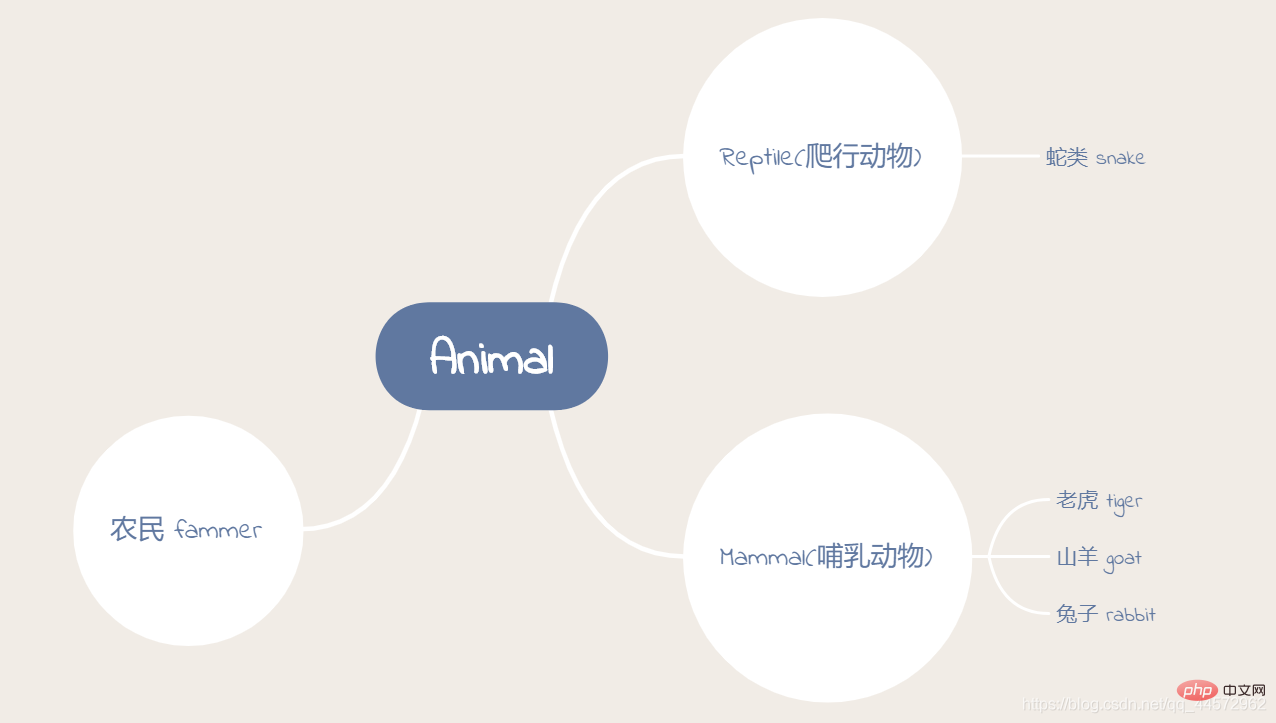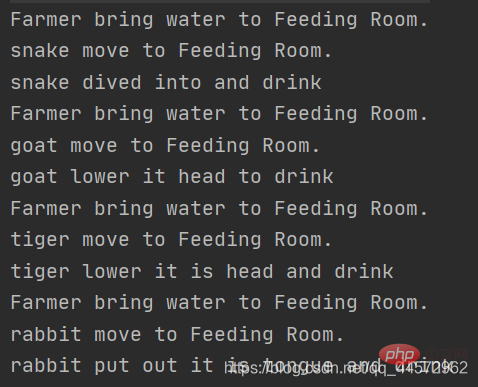Example analysis of Java abstract definition
1. Overview
In the concept of OOP, all objects are described through classes; but not all classes are used to describe objects. If a class does not contain enough information to describe a concrete object, such a class is called an abstract class.
Abstract class: (1) Abstract classes cannot instantiate objects. If an object is instantiated, compilation will not pass. Only non-abstract subclasses of abstract classes can create objects (2) that can include: member variables, member methods, constructors, etc. (3) Constructors and class methods (methods modified with static) cannot be declared as abstract methods
Abstract methods: (1) If a class contains an abstract method, then the class must be an abstract class (2) Any The subclass must override the abstract method of the parent class, or declare itself as an abstract class
Definition: abstract class Class name
2. Example: Farmers feeding animals
Animal: Abstract class--------getName(), move(), drink()
Reptile, Mammal: inherit abstract class
Snake, tiger, goat, rabbit: inherit respectively Reptile or Mammal
fammer:bringWater(), feedWater(Animal animal)---- Responsible for bringing water to the designated place, and then the animal moves to the destination and drinks water

The code is as follows:
package abstractDemo;
/**
* @author lpx
* @Description TODO
* @date 2021-04-07
*/
public abstract class Animal {
abstract String getName();
abstract void move(String destination);
abstract void drink();
}
abstract class Reptile extends Animal{
}
abstract class Mammal extends Animal{
}
class Tiger extends Mammal{
private static String name="tiger";
@Override
String getName() {
return this.name;
}
@Override
void move(String destination) {
System.out.println("tiger move to "+destination+".");
}
@Override
void drink() {
System.out.println("tiger lower it is head and drink");
}
}
class Goat extends Mammal{
private static String name="goat";
@Override
String getName() {
return this.name;
}
@Override
void move(String destination) {
System.out.println("goat move to "+destination+".");
}
@Override
void drink() {
System.out.println("goat lower it head to drink");
}
}
class Rabbit extends Mammal{
private static String name="rabbit";
@Override
String getName() {
return this.name;
}
@Override
void move(String destination) {
System.out.println("rabbit move to "+destination+".");
}
@Override
void drink() {
System.out.println("rabbit put out it is tongue and drink");
}
}
class Snake extends Reptile{
private static String name="snake";
@Override
String getName() {
return this.name;
}
@Override
void move(String destination) {
System.out.println("snake move to "+destination+".");
}
@Override
void drink() {
System.out.println("snake dived into and drink");
}
}
class Farmer{
public void bringWater(String destination){
System.out.println("Farmer bring water to " + destination + ".");
}
public void feedWater(Animal a){ // polymorphism
this.bringWater("Feeding Room");
a.move("Feeding Room");
a.drink();
}
}
class Test{
public static void main(String[] args) {
Farmer fm=new Farmer();
Snake snake=new Snake();
Goat goat=new Goat();
Tiger tiger=new Tiger();
Rabbit rabbit=new Rabbit();
fm.feedWater(snake);
fm.feedWater(goat);
fm.feedWater(tiger);
fm.feedWater(rabbit);
}
}Execution results:

package abstractDemo;
/**
* @author lpx
* @Description TODO
* @date 2021-04-07
*/
class Tiger1{
private static String name="tiger";
String getName() {
return this.name;
}
void move(String destination) {
System.out.println("tiger move to "+destination+".");
}
void drink() {
System.out.println("tiger lower it is head and drink");
}
}
class Goat1{
private static String name="goat";
String getName() {
return this.name;
}
void move(String destination) {
System.out.println("goat move to "+destination+".");
}
void drink() {
System.out.println("goat lower it head to drink");
}
}
class Rabbit1{
private static String name="rabbit";
String getName() {
return this.name;
}
void move(String destination) {
System.out.println("rabbit move to "+destination+".");
}
void drink() {
System.out.println("rabbit put out it is tongue and drink");
}
}
class Farmer1{
public void bringWater(String destination){
System.out.println("Farmer bring water to " + destination + ".");
}
public void feedWater(Goat1 goat){ // polymorphism
this.bringWater("Feeding Room");
goat.move("Feeding Room");
goat.drink();
}
public void feedWater(Tiger1 tiger){ // polymorphism
this.bringWater("Feeding Room");
tiger.move("Feeding Room");
tiger.drink();
}
public void feedWater(Rabbit1 rabbit1) {
this.bringWater("Feeding Room");
rabbit1.move("Feeding Room");
rabbit1.drink();
}
}
public class Test1{
public static void main(String[] args) {
Farmer1 farmer1=new Farmer1();
Tiger1 tiger1=new Tiger1();
Goat1 goat1=new Goat1();
Rabbit1 rabbit1=new Rabbit1();
farmer1.feedWater(tiger1);
farmer1.feedWater(goat1);
farmer1.feedWater(rabbit1);
}
}The above is the detailed content of Example analysis of Java abstract definition. For more information, please follow other related articles on the PHP Chinese website!

Hot AI Tools

Undresser.AI Undress
AI-powered app for creating realistic nude photos

AI Clothes Remover
Online AI tool for removing clothes from photos.

Undress AI Tool
Undress images for free

Clothoff.io
AI clothes remover

Video Face Swap
Swap faces in any video effortlessly with our completely free AI face swap tool!

Hot Article

Hot Tools

Notepad++7.3.1
Easy-to-use and free code editor

SublimeText3 Chinese version
Chinese version, very easy to use

Zend Studio 13.0.1
Powerful PHP integrated development environment

Dreamweaver CS6
Visual web development tools

SublimeText3 Mac version
God-level code editing software (SublimeText3)

Hot Topics
 1386
1386
 52
52
 Perfect Number in Java
Aug 30, 2024 pm 04:28 PM
Perfect Number in Java
Aug 30, 2024 pm 04:28 PM
Guide to Perfect Number in Java. Here we discuss the Definition, How to check Perfect number in Java?, examples with code implementation.
 Weka in Java
Aug 30, 2024 pm 04:28 PM
Weka in Java
Aug 30, 2024 pm 04:28 PM
Guide to Weka in Java. Here we discuss the Introduction, how to use weka java, the type of platform, and advantages with examples.
 Smith Number in Java
Aug 30, 2024 pm 04:28 PM
Smith Number in Java
Aug 30, 2024 pm 04:28 PM
Guide to Smith Number in Java. Here we discuss the Definition, How to check smith number in Java? example with code implementation.
 Java Spring Interview Questions
Aug 30, 2024 pm 04:29 PM
Java Spring Interview Questions
Aug 30, 2024 pm 04:29 PM
In this article, we have kept the most asked Java Spring Interview Questions with their detailed answers. So that you can crack the interview.
 Break or return from Java 8 stream forEach?
Feb 07, 2025 pm 12:09 PM
Break or return from Java 8 stream forEach?
Feb 07, 2025 pm 12:09 PM
Java 8 introduces the Stream API, providing a powerful and expressive way to process data collections. However, a common question when using Stream is: How to break or return from a forEach operation? Traditional loops allow for early interruption or return, but Stream's forEach method does not directly support this method. This article will explain the reasons and explore alternative methods for implementing premature termination in Stream processing systems. Further reading: Java Stream API improvements Understand Stream forEach The forEach method is a terminal operation that performs one operation on each element in the Stream. Its design intention is
 TimeStamp to Date in Java
Aug 30, 2024 pm 04:28 PM
TimeStamp to Date in Java
Aug 30, 2024 pm 04:28 PM
Guide to TimeStamp to Date in Java. Here we also discuss the introduction and how to convert timestamp to date in java along with examples.
 Java Program to Find the Volume of Capsule
Feb 07, 2025 am 11:37 AM
Java Program to Find the Volume of Capsule
Feb 07, 2025 am 11:37 AM
Capsules are three-dimensional geometric figures, composed of a cylinder and a hemisphere at both ends. The volume of the capsule can be calculated by adding the volume of the cylinder and the volume of the hemisphere at both ends. This tutorial will discuss how to calculate the volume of a given capsule in Java using different methods. Capsule volume formula The formula for capsule volume is as follows: Capsule volume = Cylindrical volume Volume Two hemisphere volume in, r: The radius of the hemisphere. h: The height of the cylinder (excluding the hemisphere). Example 1 enter Radius = 5 units Height = 10 units Output Volume = 1570.8 cubic units explain Calculate volume using formula: Volume = π × r2 × h (4
 Create the Future: Java Programming for Absolute Beginners
Oct 13, 2024 pm 01:32 PM
Create the Future: Java Programming for Absolute Beginners
Oct 13, 2024 pm 01:32 PM
Java is a popular programming language that can be learned by both beginners and experienced developers. This tutorial starts with basic concepts and progresses through advanced topics. After installing the Java Development Kit, you can practice programming by creating a simple "Hello, World!" program. After you understand the code, use the command prompt to compile and run the program, and "Hello, World!" will be output on the console. Learning Java starts your programming journey, and as your mastery deepens, you can create more complex applications.




